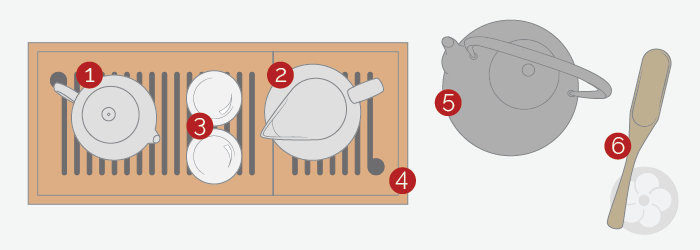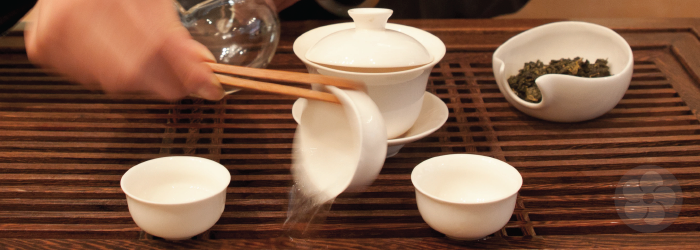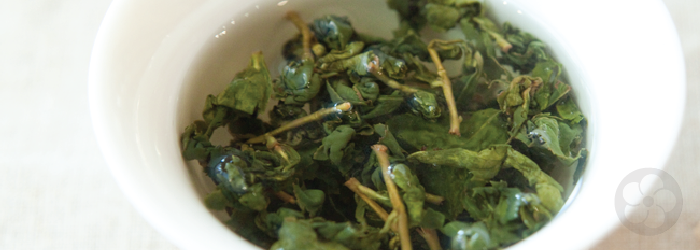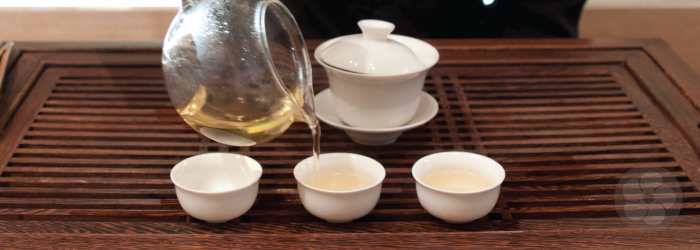Gong fu cha is sometimes called the “Chinese tea ceremony”. But while the process can look complex, it is not truly a formalized ceremony. The literal translation of gong fu is “right effort”, while cha means “tea”. Thus, gong fu cha is only the process of putting in the effort to get the best flavor from the tea. In many ways, the resulting cup is like an espresso. By contrast, western brewing methods create something more like a big pot of coffee.
Using a small brewing vessel, tea is steeped in concentrated quantities. Water is added to the same tea leaves many times. Each infusion is tasted independently to observe changes in flavor. In this way, tea drinkers can verify and appreciate the quality of the tea. This method also maximizes the quantity of brewed tea from each serving of leaves.
Gong Fu Cha Tools
A few pieces of teaware are required for this traditional brewing method. A basic gong fu cha setup includes:
1. Teapot or Gaiwan
The size of the brewing vessel is often the most jarring detail for those unfamiliar with gong fu cha. In order to brew a concentrated cup, the pot or gaiwan usually holds less than 8 ounces. For brewing a variety of teas or checking the quality of our leaves, we prefer to use a glazed porcelain gaiwan. But serious connoisseurs may prefer to use small unglazed yixing pot, dedicated to a single style of tea.
2. Server
To control the strength of the brew, the tea is decanted from the brewing vessel after a set amount of time. This also ensures that the tea leaves do not continue to steep between each pour. The goal is for each cup to contain an even brew.
3. Tea Cups
Tea cups used in gong fu cha are also quite small. The size encourages tea drinkers to focus on the depth and complexity of flavor in each sip. But this doesn’t limit the amount of tea consumed. Cups are continually refilled with each new infusion.
4. Tea Tray
Traditional gong fu cha involves quite a bit of excess water, used to rinse and warm the teaware. A tea tray with some sort of drainage or reservoir removes this water from the brewing area. It also protects the table underneath from water damage.
5. Kettle
Hot water is essential to brew any tea. Gong fu cha requires that the water be kept hot to brew many infusions. In the past, brewers managed this with a cast iron kettle and a brazier. But we find an electric kettle to be a convenient modern version.
6. Scoop
To avoid breaking or contaminating tea leaves, we like to use a scoop to measure them out. When brewing a bing or "cake", a tea pick is useful for separating the desired amount of leaves.
Browse our collection of gong fu cha teaware to start brewing better tea today >>
Optional Accessories
These accessories are not required, but they can help to brew with precision.
Tongs - When brewing for guests, tongs are used to handle small cups more easily during the rinsing stage.
Towel - A small tea towel is convenient for wiping up errant spills outside of the tea tray. It can also help keep the brewing surface dry.
Scale - A gram scale is the only way to precisely measure the quantity of leaves used, as teas can vary wildly in volume.
Trivets - Trivets act as a decorative accessory, and can make small cups easier to hold.
Strainer - Most Chinese teas use whole leaves. These are easy to strain with the features of a traditional brewing vessel. If using a tea with smaller broken bits, a fine mesh strainer can help keep them out of the server and drinking cups.
Preparation
You've assembled your tools and selected a tea. Now it’s time to prepare the components of gong fu cha with a few simple steps.
Heat Water
Bring the water to the correct temperature for the selected tea. Green and white teas require relatively cool temperatures. Darker teas are best brewed with hotter water.
Measure Tea Leaves
Eyeball the amount of tea leaves to use, or weigh your leaves for a precise ratio.
Rinse Teaware
Set the brewing vessel, server, and cups on the tea tray. Add heated water to the brewing vessel, and then pour the rinse water into the server. Pour the water from the server into the cups, and then empty each cup onto the tea tray. Using tongs to handle and rinse the warmed cups will keep fingers cool and cups clean.
Steeping
Okay, now for the fun part. Ready to make a delicious cup of tea?
Add Tea Leaves
Place the dry tea leaves into the warmed teapot or gaiwan. Offer the leaves to smell at this stage, so your guests can appreciate their fullest aroma. An optional step is to rinse the tea leaves at this stage. Add just enough water to cover the leaves, and decant immediately. This step will not extract much flavor and the rinse water can be discarded. But it can help to “wake up” the leaves, especially if they are rolled or compressed.
Add Water
Pour heated water over the tea leaves. With practice, a precise pour can circulate the leaves and improve the brew. A yixing pot is usually filled to the brim. But if using a gaiwan, it is best to leave some space at the top. This will make it easier to decant and avoid burning fingers. Replace the lid of your vessel to retain heat.
Allow the Leaves to Steep
The correct amount of steeping time varies based on the type of tea used. To check the progress of the brew, lift the lid for a moment and observe the color and expansion of the leaves. Decant the brewed tea and serve. Pour all liquid from the brewing vessel into the server. Pour from the server into the cups to ensure everyone at the table has an even brew.
Serve
Encourage your guests to aerate the tea (as if tasting wine) to pick up the fullest flavor. To do this, they can take a small sip and slurp, drawing air through the tea in the mouth. This will help to spread flavor to every part of the palate.
Re-Steep
Add more hot water to your tea leaves. Our favorite way to check the quality of any tea is to observe the way the flavor changes with each infusion. For most natural teas, the fullest flavor is not clear until the second or third infusion. The flavor should last through at least three infusions, depending on the tea. Brewing with higher concentrations of leaf can produce more infusions.
Variations
The version of gong fu cha that we know today derives from a specific regional style. While this method developed in Chaozhou, China is a huge country. Thus, this style of brewing is in no way standardized, and there are many variations on these basic steps.
Dry Brewing
Modern interpretations of gong fu cha simplify the setup. They do away with the traditional tea tray. Instead, this “dry” style uses a minimal amount of excess water and discards any rinse water into a large bowl. A simple flat tray, or a wide bowl with a small stand may still be used. This "tea boat" will hold the brewing vessel and catch any spills that might occur.
Simplified Gong Fu Cha
To brew gong fu cha for one person, the server can be removed from the process. Instead, decant from the brewing vessel into the drinking cup. For portability, the tool kit can even include only a brewing vessel and cup.
Chaozhou Style
The form of gong fu cha that we know today is an amalgamation of brewing techniques from across China. But the most rigorous version is the original method from Chaozhou. This original version of the method developed to extract good flavor from low grade teas. The brewer fills a small pot 80% full of leaves, with whole leaves surrounding crushed bits. With boiling water, these leaves steep for mere seconds.
Checking Leaf Quality
As mentioned before, leaf quality can be checked by tasting many infusions. Observing changes in flavor makes quality obvious. Chopped or flavored leaves will lose flavor over the course of several infusions. They will get weaker after the first brew. By contrast, natural whole leaf teas will intensify in flavor. They should get better and better through at least the second or third brew.
To further test the quality of a tea, we often experiment with brewing parameters. The best teas taste good no matter how they’re brewed. Gradually increasing time or temperature to “over brew” the leaves can be a great test of quality.







